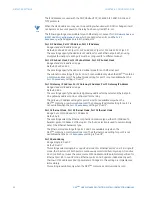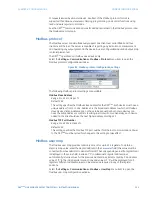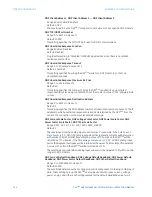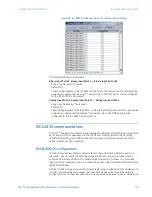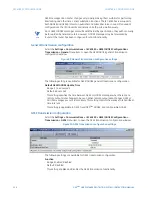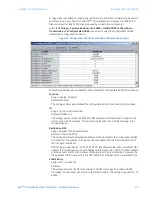
CHAPTER 6: COMMUNICATIONS
DNP COMMUNICATIONS
D90
PLUS
LINE DISTANCE PROTECTION SYSTEM – INSTRUCTION MANUAL
105
analog input points of that type. For example, to trigger unsolicited responses from the
D90
Plus
when any current values change by 15 amps, the
DNP Current Default Deadband
setting should be set to “15”.
These settings are the deadband default values. DNP object 34 points can be used to
change deadband values from the default for each individual DNP analog input point.
Whenever power is removed and re-applied to the D90
Plus
, the default deadbands will
be in effect.
DNP Time Sync IIN Period
Range: 1 to 10080 minutes in steps of 1
Default: 1440 minutes
This setting determines how often the Need Time Internal Indication (IIN) bit is set by the
D90
Plus
. Changing this time allows the DNP master to send time synchronization
commands more or less often, as required.
DNP Message Fragment Size
Range: 30 to 2048 in steps of 1
Default: 240
This setting determines the size, in bytes, at which message fragmentation occurs. Large
fragment sizes allow for more efficient throughput; smaller fragment sizes cause more
application layer confirmations to be necessary which can provide for more robust data
transfer over noisy communication channels.
DNP Object 1 Variation, DNP Object 2 Variation, DNP Object 20 Variation, DNP Object
21 Variation, DNP Object 22 Variation, DNP Object 23 Variation, DNP Object 30
Variation, DNP Object 32 Variation
Range: 1, 2 (object 1); 1, 2, 3 (object 2), 1, 2, 5, 6 (objects 20, 22, and 23); 1, 2, 9, 10 (object
21); 1, 2, 3, 4, 5 (object 30); 1, 2, 3, 4, 5, 7 (object 32)
Default 1 (objects 20, 21, 22, 23, 30, and 32); 2 (objects 1 and 2)
These settings allow the user to select the DNP default variation number for object types
1, 2, 20, 21, 22, 23, 30, and 32. The default variation refers to the variation response when
variation 0 is requested or in class 0, 1, 2, or 3 scans.
DNP Number of Paired Controls
Range: 0 to 32 in steps of 1
Default: 0
The DNP binary outputs typically map one-to-one to IED data points. That is, each DNP
binary output controls a single physical or virtual control point in an IED. In the D90
Plus
,
DNP binary outputs are mapped to protection and/or automation virtual inputs.
Mapping is updated in the web page browser. Use this DNP Points Lists web page to
verify the DNP configuration.
Some legacy DNP implementations use a mapping of one DNP binary output to two
physical or virtual control points to support the concept of trip/close (for circuit breakers)
or raise/lower (for tap changers) using a single control point. That is, the DNP master can
operate a single point for both trip and close, or raise and lower, operations. The
D90
Plus
can be configured to support paired control points, with each paired control
point operating two virtual inputs (protection or automation). This setting allows
configuration of 0 to 32 binary output paired controls. The paired control mapping is
reverse paired order, meaning that is starts backward from the end of the Control
Outputs List. For example, when the DNP Number of Paired Controls setting is
configured as 4, the DNP Points Lists web page shows Automation Virtual Inputs 121 to
128 are paired, as shown in the figure.


